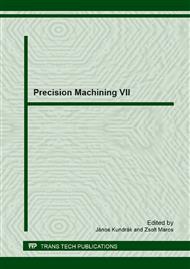[1]
P. G. Benardos, G. C. Vosniakos, Prediction surface roughness in machining: a review, International Journal of Machine Tool and Manufacturing. 43 (2003) 833-844.
DOI: 10.1016/s0890-6955(03)00059-2
Google Scholar
[2]
I. P. Arbizu, C. J. L. Perez, Surface roughness prediction by factorial design of experiments in turning processes, Journal of Materials Processing Technology. 143-144 (2003) 390-396.
DOI: 10.1016/s0924-0136(03)00407-2
Google Scholar
[3]
F. Klocke, S. Gierlings, M. Brockmann, C. Sage, D. Veselovac, Adaptive Control of Manufacturing Processes for a New Generation of Jet Engine Components, 7th CIRP – ICME, Capri, 2010, p.321.
Google Scholar
[4]
V. Bana, B. Karpuschewski, J. Kundrák, A. M. Hoogstrate, Thermal distortions in the machining of small bores, Journal of Material Processing Technology. 191 (2007) 335-338.
DOI: 10.1016/j.jmatprotec.2007.03.027
Google Scholar
[5]
F. J. Pontes, A. P. de Paiva, P. P. Balestrassi, J. R. Ferreira, M. B. da Silva, Optimization of Radial Basis Function neural network employed for prediction of surface roughness in hard turning process using Taguchi´s orthogonal arrays, Expert Systems with Applications. 39 (2012).
DOI: 10.1016/j.eswa.2012.01.058
Google Scholar
[6]
I. Asiltürk, M. Çunkas, Modeling and prediction of surface roughness in turning operations using artificial neural network and multiple regression method, Expert System with Applications. 38 (2011) 5826-5832.
DOI: 10.1016/j.eswa.2010.11.041
Google Scholar
[7]
D. Karayel, Prediction and control of surface roughness in CNC lathe using artificial neural network, Journal of Material Processing Technology. 209 (2009) 3125-3137.
DOI: 10.1016/j.jmatprotec.2008.07.023
Google Scholar
[8]
V. Dutilh, G. Dessein, J. Alexis, G. Perrin, Links between machining parameters and surface integrity in drilling Ni-superalloy, International Journal of Advanced Materials Research. 112 (2010) 171-178.
DOI: 10.4028/www.scientific.net/amr.112.171
Google Scholar
[9]
A. Popa, G. Dessein, M. Baili, V. Dutilh, Investigation of Tool Failure Modes and Machining Disturbances Using Monitoring Signals, International Journal of Advanced Materials Research. 423 (2012) 128-142.
DOI: 10.4028/www.scientific.net/amr.423.128
Google Scholar
[10]
J. P. Davim, V. N. Gaitonde, S. R. Karnik, Investigation into the effect of cutting conditions on surface roughness in turning of free machining steel by ANN models, Journal of Materials Processing Technology. 205 (2008) 16-23.
DOI: 10.1016/j.jmatprotec.2007.11.082
Google Scholar
[11]
V. Upadhyay, P. K. Jain, N. K. Mehta, In – process prediction of surface roughness in turning of Ti-6Al-4V alloy using cutting parameters and vibration signals, Measurement. 46 (2013) 154-160.
DOI: 10.1016/j.measurement.2012.06.002
Google Scholar
[12]
M. T. Hayajneh, A. M. Hassan, A. T. Mayyas, Artificial neural network modeling of the drilling process of self-lubricated aluminum/alumina/graphite hybrid composites synthesized by powder metallurgy technique, Journal of Alloys and Compounds. 478 (2009).
DOI: 10.1016/j.jallcom.2008.11.155
Google Scholar


